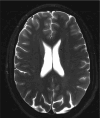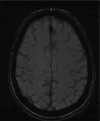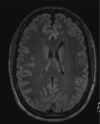Five-Year Serial Brain MRI Analysis of Military Members Exposed to Chronic Sub-Concussive Overpressures
- PMID: 38760963
- PMCID: PMC11645495
- DOI: 10.1002/jmri.29419
Five-Year Serial Brain MRI Analysis of Military Members Exposed to Chronic Sub-Concussive Overpressures
Abstract
Background: The Canadian Special Operations Forces Command conducts explosives operations and training which exposes members to explosive charges at close proximity. This 5-year longitudinal trial was conducted in follow-up to our initial trial which examined military breachers with MRI and EEG pre and post blast exposure.
Purpose: To examine brain MRI findings in military personnel exposed to multiple repeated blast exposures.
Study type: Five-year longitudinal prospective trial.
Population: Ninety-two males aged 23-42 with an average of 9.4 years of blast exposure.
Field strength/sequence: 3 T brain MRI/T1-weighted 3D with reconstruction in three planes, T2-weighted, T2-weighted fluid attenuated inversion recovery (FLAIR) 3D with reconstruction in three planes, T2-weighted gradient spin echo (GRE), saturation weighted images, DWI and ADC maps, diffusion tensor imaging.
Assessment: All MRI scans were interpreted by the two neuroradiologists and one neuroradiology Fellow in a blinded fashion using a customized neuroradiology reporting form.
Statistical tests: Matching parametric statistics represented the number of participants whose brain parameters improved or deteriorated over time. Odds ratio (OR) and 95% confidence intervals (CI) were computed using log regression modeling to determine volume loss, white matter lesions, hemosiderosis, gliosis, cystic changes and enlarged Virchow Robin (VR) spaces. A Kappa (κ) statistic with a 95% CI was calculated to determine rater variability between readers.
Results: A significant deterioration was observed in volume loss (OR = 1.083, 95% CI 0.678-1.731, permutation test), white matter changes (OR: 0.754, 95% CI 0.442-1.284, permutation test), and enlargement of VR spaces (OR: 0.775, 95% CI 0.513-1.171). Interrater reliability was low: κ = 0.283, 0.156, and 0.557 for volume loss, white matter changes, and enlargement of VR spaces, respectively.
Data conclusion: There were significant changes in brain volume, white matter lesions, and enlargement of VR spaces.
Evidence level: 2 TECHNICAL EFFICACY: Stage 2.
Keywords: MRI; brain volume loss; cavernoma; chronic traumatic encephalopathy; developmental venous anomaly (DVA).
© 2024 The Authors. Journal of Magnetic Resonance Imaging published by Wiley Periodicals LLC on behalf of International Society for Magnetic Resonance in Medicine.
Figures



Similar articles
-
Longitudinal analysis highlights structural changes in grey- and white-matter within military personnel exposed to blast.Brain Inj. 2025 May 12;39(6):509-517. doi: 10.1080/02699052.2024.2446948. Epub 2024 Dec 27. Brain Inj. 2025. PMID: 39729051
-
Findings from Structural MR Imaging in Military Traumatic Brain Injury.Radiology. 2016 Apr;279(1):207-15. doi: 10.1148/radiol.2015150438. Epub 2015 Dec 15. Radiology. 2016. PMID: 26669604
-
Neuropsychological, Neurocognitive, Vestibular, and Neuroimaging Correlates of Exposure to Repetitive Low-Level Blast Waves: Evidence From Four Nonoverlapping Samples of Canadian Breachers.Mil Med. 2021 Jan 30;186(3-4):e393-e400. doi: 10.1093/milmed/usaa332. Mil Med. 2021. PMID: 33135742
-
Diffusion-weighted MR of the brain: methodology and clinical application.Radiol Med. 2005 Mar;109(3):155-97. Radiol Med. 2005. PMID: 15775887 Review. English, Italian.
-
Neuroimaging in Blast-Related Mild Traumatic Brain Injury.J Head Trauma Rehabil. 2017 Jan/Feb;32(1):55-69. doi: 10.1097/HTR.0000000000000213. J Head Trauma Rehabil. 2017. PMID: 27022955 Review.
Cited by
-
An Objective Assessment of Neuromotor Control Using a Smartphone App After Repeated Subconcussive Blast Exposure.Sensors (Basel). 2024 Nov 2;24(21):7064. doi: 10.3390/s24217064. Sensors (Basel). 2024. PMID: 39517961 Free PMC article.
-
Does white matter and vascular injury from repetitive head impacts lead to a novel pattern on T2 FLAIR MRI? A hypothesis proposal and call for research.Alzheimers Dement. 2025 Mar;21(3):e70085. doi: 10.1002/alz.70085. Alzheimers Dement. 2025. PMID: 40145364 Free PMC article. Review.
-
Canadian radiology: 2025 update.Jpn J Radiol. 2025 Aug 28. doi: 10.1007/s11604-025-01862-x. Online ahead of print. Jpn J Radiol. 2025. PMID: 40875087 Review.
References
-
- War and Health . Volume 9: Long‐term effects of blast exposures. Washington, DC: The National Academies Press; 2014. p 228. - PubMed
-
- Priemer DS, Iacono D, Rhodes CH, Olsen CH, Perl DP. Chronic traumatic encephalopathy in the brains of military personnel. N Engl J Med 2022;386(23):2169‐2177. - PubMed
MeSH terms
Grants and funding
LinkOut - more resources
Full Text Sources
Medical
Research Materials

